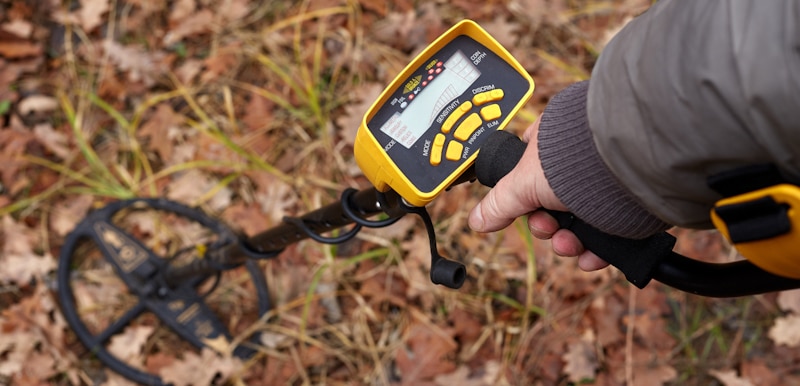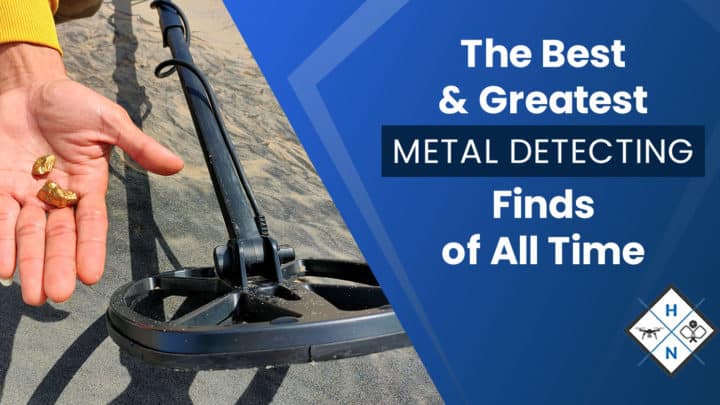There are tons of hobbies people have taken up; most of these hobbies are for fun. When people decide to take up a hobby, they rarely consider the investment needed for it and its value. This is because they do it for pleasure; nevertheless, metal detecting is a hobby that can eventually pay off in the long run.
Some of the best and greatest metal detecting finds of all time are the golden chalice, gold iron age necklaces, a ring, and finger bone, a 2-pound meteor, a bronze age ax head, the Staffordshire hoard, the saddle ridge hoard, the Watlington Hoard, the chew valley hoard, and lost class ring.
It is very rare to have a hobby where you can find a valuable prize while taking a walk and enjoying the peace of the day. Engaging in metal detecting will most likely affect your other hobbies, but your chances of finding a prize are high.

Best Metal Detector Finds
Most of the most amazing metal detecting discoveries occurred in the United Kingdom. Although the United States of America has a sizable fanbase, the best discoveries have been made elsewhere. Some of the best metal detector finds are below.
Golden Chalice
A 385-year-old gold chalice from the Spanish ship called Santa Margarita was found by treasure hunter Mike DeMar in 2008 while diving off the coast of Key West. The ship sank in 1622 with buried wealth on board. A staggering $1 million was given to Mike DeMar as compensation.
Buried Treasure
Most of these discoveries could be categorized as "hidden riches," but Eric Lawes' discovery was a little more remarkable. Eric Lawes discovered silver spoons, gold jewelry, and an abundance of silver and gold while looking for his friend's misplaced hammer.
Lawes brought the two bags of goods to the council and informed them of his discovery. The following day, archaeologists discovered 52.4 pounds of silver and 7.7 pounds of gold. The cache of coins, valued at around $2.59 million, was buried probably later than 450 AD.
Viking Treasure Trove
David and Andrew Whelan, father and son, discovered a single coin in 2007. While this could be sufficient for some, the determined duo persisted and eventually discovered a vast amount of Viking silver and gold treasure. The treasure, worth about $750,000, was discovered on a farm in North Yorkshire.
The farmer who owned the farm it was discovered on kept the other half, and the duo pocketed half the money. An ornate gilded and silver cup, a solid gold band, brooch pins, 617 coins, and other silver objects make up the treasure, which is now exhibited at the British Museum.
Weird Metal Detector Finds
Not simply your regular coins, golden chains, rings, and strange jewelry pieces are discovered using metal detectors. During searches, you will occasionally make some odd metal detector findings, which are frequently the most memorable ones. Below are some weird metal detector finds.
Sputnik Sinkers
Many anglers use Sputnik sinkers throughout the world. Four metal hooks protrude from the center portion of the tiny devices. In July 2014, David Monsen discovered two of these substantial Sputnik sinkers while looking in Nags Head, North Carolina. If someone had trodden on one, a journey to the doctors and a tetanus treatment were required.
Space Iron
David Eichner Sr. was looking for antiquities and relics on a Civil War battlefield. Buckles, buttons, and the occasional cannonball were popular targets at this time. Helmets and military shackles are common remnants from this period. In this tale, he found an item nine inches underground using his metal detector.
To uncover two chunks of space iron, Eichner dug down. After showing it to an archeologist, Eichner learned that it was an iron fragment that landed on earth millennia ago. At the time, he had no idea what it was; that was really a strange metal detector discovery.
An Odd Copper Piece
Jack Hart discovered some peculiar things at his home on Virginia's Chesapeake Bay. Among Hart's strange metal detector discoveries was a 10-inch by 6-inch chunk of the copper sheet. Hart discovered another sliver of copper as he drilled a nine-inch hole. The object was round and six inches tall. Hart had no understanding of what his strange metal detector finds were, which weighed roughly six pounds.
How To Dig Up A Metal Detector Finds
One of the few pastimes, metal detecting, when carried out by someone who does not bother, can undoubtedly result in significant property damage. The main reason the pastime is prohibited in several parks and forest preserves is that it leaves gaping holes in the soil and tramples grass.
Always try your hardest to be considerate when metal detecting and restoring the grass in the same condition as when you found it. Once it is very hot outside, digging soil plugs to recover metal detecting discoveries will quickly damage vegetation.
Digging down plants with a shovel when the ground is parched and extremely hot rapidly kills grass and produces yellow rings in the area where you dug. The greatest seasons to go metal detecting are the spring and fall, as well as right after a significant amount of rain whenever the soil is really wet.
In spite of the frequent use of the word "digging," we really "cut" a dirt plug just as much as we probably dig. A metal detecting shovel with serrated edges works best for cutting dirt plugs. Leave some dirt connected if you cut a plug of dirt to make a flap. In this manner, the plug fits back into the earth like a puzzle piece once you fill the hole.
Place the dirt plug over a napkin or a small towel to capture the loose dirt and keep the lawn appearing clean while you leave. When metal detecting on grass, this easy tip makes a big impact.

How To Clean Metal Detector Finds
If you like the sport of metal detecting, you know how uncommon it is to unearth an item in excellent condition. Every day they remain underground, and coins and artifacts become less attractive. Hence, cleaning your metal detector finds after recovering them is necessary to make them new and clean again is necessary.
The best technique to cleanse a relic or coin is to immerse it in warm, soapy distilled water for a few minutes before rinsing it. Olive oil is suitable for grime that has been caked on more. Olive oil does, however, contain fatty acids that, when left on a coin for a lengthy period, might damage it. It is best to use mineral oil because of this.
It is best to soak the item for between 24 and 48 hours before giving it a good wash with Dawn dish soap or acetone to get rid of any remaining olive oil. Following a 24 to 48-hour soak, to eliminate the loose dirt, use a toothpick or a medium-soft brush. The best method to use is presumably the hydrogen peroxide soak.
By shaking the dirt out from the coin, the bubbles begin to function almost immediately. However, it also works directly out of the bottle at ambient temperature. Some people choose to warm the hydrogen peroxide in a microwave. To ensure there is no cracking or corrosion, periodically inspect the coin with a magnifying glass or a jeweler's loupe.
Final Thoughts
Even though finds under $1,000,000 in value are rarely reported in the news, they are frequently reported in metal detecting communities, which may make for some very fascinating reading. Over the years, some fairly strange things have been found. Although the likelihood of discovering treasure valued at millions of dollars is remote, using a metal detector in the appropriate location still gives you a fair chance of discovering something intriguing.
Shawn Manaher loves to play with new toys and dive into new hobbies. As a serial entrepreneur, work definitely comes first but there is always room for hobbies.

